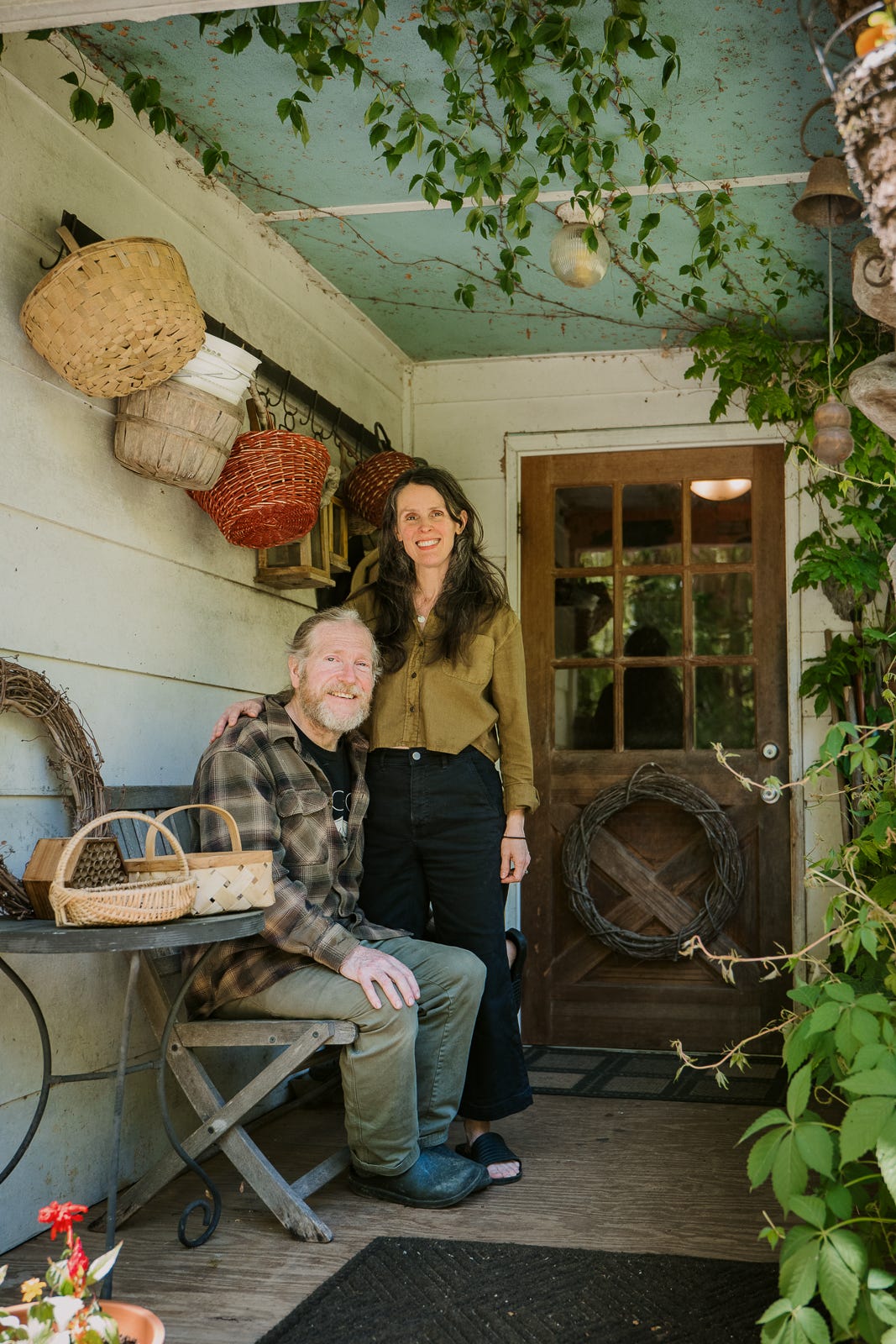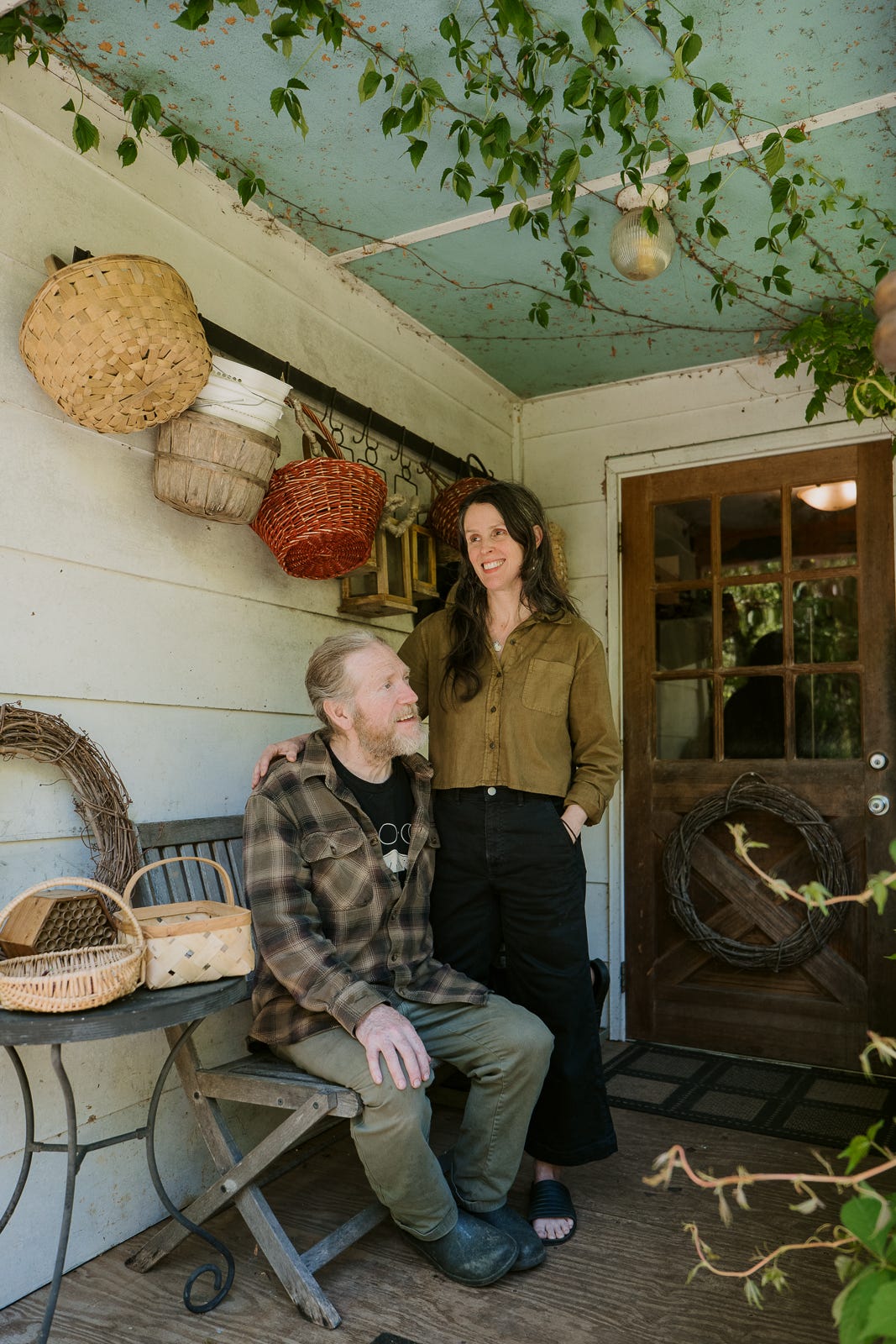Abodes of Appalachia: Featuring Ashley & Glenn English
Authors and Homesteaders share the story of their Craftsman Bungalow Cove
Hi friends!
Welcome to 'Abodes of Appalachia,' a captivating series that delves into the heart and homes of the people who live amongst the rolling hills of the Blue Ridge Mountains.
In this unique exploration, we celebrate the soulful essence of the Appalachian Region through the lens of interior design and the stories that dwell within these walls.
My mission is to showcase the beauty found in the everyday lives of individuals who have woven their existence into the fabric of this land.
Join us as we peel back the layers of their homes, revealing the authentic, inspiring, and real narratives that make up the rich tapestry of Appalachian life, proving that wealth is not measured in dollars but in the spirit of the people who call this place home.
As someone whose personal heritage is rooted here in Western North Carolina, this series is particularly special to me. What a joy and honor it is to be welcomed into local people's homes to photograph and interview them; A magical mix of my love for photography, design, and asking lots of questions!
(This series will be too long for email, so be sure to read it via the Substack app or website)
Meet Ashley & Glenn English;
Writers, Artists, and Homesteaders
www.smallmeasure.com
@smallmeasure
@thebewilderment
It was warm, sunny day in mid April. The windows were rolled all the way down on the 2003 Toyota Avalon that was passed down to me from my Mamaw (you can read about that story here). I was headed a ways North-West to meet two inspiring folks that I’ve been eager to meet for months.
I followed the detailed list of text directions Ashley sent my way the day before. Taking my time to ensure I take each turn as directed, I know I’m likely annoying every local who pulls up behind me on their way home. Like most places around here, once you get on the back roads, you lose cell service. Since I was warned that my GPS would likely get me lost (and I really don’t like being late) I mindfully wind my way through the countryside with caution.
I giggle as I read each step on the list containing a personalized note:
“Unfortunately, the street sign may be gone there. People keep stealing it, boo!!”
”This is our road, but the street sign is gone as well (WHYYY??!!)”
Instead, I look for the high bridge, the yellow-ish little house, and the small magnolia. I realize I prefer this type of guidance anyway. Arbitrary names seem less important than the landmarks that hold physical space, more defining of the places we live.
Once I make it onto their dirt drive, the green seems to roll on forever. Grassy fields and the budding trees of early Spring line two dusty strips disappearing into the horizon.
I eventually pull into the drive and Ashley is there waiting on me. I wave and smile at this sweet cottage, tucked into the folds of a Blue Ridge bend. It’s a very special space, this home they have created together. I’m so excited for you to get a peek into their lives and their story.
Read on for their interview and photos of their beautifully unique homestead:




Can you tell us a bit about the history of your current home?
Our house was built from Craftsman bungalow plans purchased from Sears. It was started in the late 1920s, and finished in the early early 1930s. It had no insulation or indoor plumbing. Much of it was built from wood felled from trees on the property.
We’ve met two members of the family that originally built the house, the oldest of which passed away a couple of years ago, in her late 90s.
We bought the home from a couple who had lived here for 17 years, and used the land and greenhouses for a farm that grew edible flowers and herbs. While the previous owners lived here, monks from a monastery in Tibet approached them about planting an urn filled with sacred items from their monastery on the land, because they believed this property was a special place along spiritual lay lines. The urn is planted by the well. They gave us a magazine article about the planting of the urn, but we accidentally misplaced it.
The previous owners also hired the head of the Green Building Council to build an extension off of the kitchen.
Where are you from? Does your personal history of you and your family (or families) impact your design styles?
Glenn: I was born outside of Philadelphia and raised in NJ, outside of NYC. I have family in the area going back to colonial times. One of my relatives, Captain James Jack, was involved in the creation of WNC, which used to be part of Tennessee. There is a statue of him in Charlotte, celebrating his ride to declare independence from the British. Every May 20th, there is a celebration of his ride, called Mecklenburg Day, and there is a license plate dedicated to it (“First in Freedom”).
Ashley: I was born outside of Chicago, and relocated to the coastal area of southeastern Virginia a year later. From there, we moved to eastern NC when I was 10. I spent most of my adolescence in NC, either on the coast or up in the mountains. After spending my freshman and sophomore years at UNC-Asheville, I moved to the Northern Virginia/DC area for several years before returning to western NC in 2000. My mom and dad (who separated when I was very young-18 months-and divorced when I was 3), both loved decorating and interior design. I absolutely can trace my affinity for home decor in equal measures to them.







Did you design your home yourself or did you have any help?
Because the house originally had no plumbing, the bathroom was an afterthought installed in one of the bedrooms. Glenn designed a new bathroom with a garden tub and ceramic tile shower, which was installed by local builders. He also opened up the entryway between the kitchen and dining room, and had the builders convert one of the upstairs bedrooms into a second bathroom. The house was built before closets were common, so he had drawers and cabinets built into the master bedroom, which he hand finished.
If you had to describe your design styles, how would you do that?
It’s definitely eclectic, but “goblincore” is probably the most accurate descriptor. We draw heavily not only on natural materials, but on natural relationships as well.
Biodiversity and the interrelated complexity of the “wood wide web” informs the interconnected aesthetics across every room of the house. We’ve tried to repeat natural patterns across every room, from shapes, to materials, to textures, such as playful groups of circular mirrors evocative of bubbles, mushroom art, and stars.
Art ranging from thrift store finds, to recombined found objects, to paintings by semi-famous artists are often reworked and overlaid with hand-drawn geodesic webs evocative of mycelial networks and molecular structures. We’ve placed them in every room of the house to reflect and include the interconnected nature of the forest ecology around us.
Where do you pull inspiration from when designing your spaces?
Nature for sure, but truly in the broadest sense, where the term is all-inclusive, encompassing every thing we see and interact with, including ourselves and each other. We look at technology as a “natural” extension of that, so electric devices are no less a part of the natural environment that circumscribes our living environment. The place of nature in our design inspiration is a matter of harmony and playfulness, not dichotomy or reductivism. The spice rack is a utilitarian technology in our house every bit as much as the electric kettle, the stove, or even the computers.
No doubt, born out of that playful embrace of wonder across the material world, there is a menagerie that some folks find reminiscent of a Victorian explorer’s curiosity cabinets, or science and nature museum.
Do you have a current favorite or most sentimental room in your home?
Not really, because we both very much see all of the rooms, and even the staircases and hallways, in relation to one another. Doors divide most of the rooms, but they don’t pass their interconnectedness. The mirrored imagery, colors, textures, and ideas that are mirrored throughout the space, much like plants, rocks, and soil in the forest, make it so that the gestalt of every room’s aesthetic is only whole in relation to all the others.
Do you mind sharing a bit about what you do for work/art/creativity and how that relates to your home space?
Glenn: My Master’s degree from UPenn was in fine art, which was combined with the architecture school. My degree work combined coursework in cognitive neuroscience and an emphasis on color theory, which is what originally brought me to the Asheville area. For both undergrad and grad school I had studied under students of Josef Albers, who left the Bauhaus to run Black Mountain College, where he created the most renowned approach to color theory in education. I also studied and worked at the grad program at the Institute for Social Ecology, which focuses on ecology as it relates to philosophy, political science, and women’s studies. That had and continues to have an enormous influence on my worldview and aesthetic approach as well. After college I worked as a color consultant for businesses and homes, and extensively consulted for neuroscientists and researchers in the study of the intersection of aesthetics and cognitive neuroscience.
Ashley: Everything that I do for capital W “Work” is related to the home. From books on food preserving, keeping chickens and bees, hosting potlucks, and orchestrating seasonal picnics, to baking pies, making homemade beverages, and creating a health and wellness apothecary, all of my writings and classes fall under the overarching umbrella of Home. I typically tell folks that if a topic is in any way related to the home, I’ve likely either written about it, am thinking of writing a book about it, or am passionate about it. I’m a Cancer (7/11) and we Crabs love all things related to domesticity!


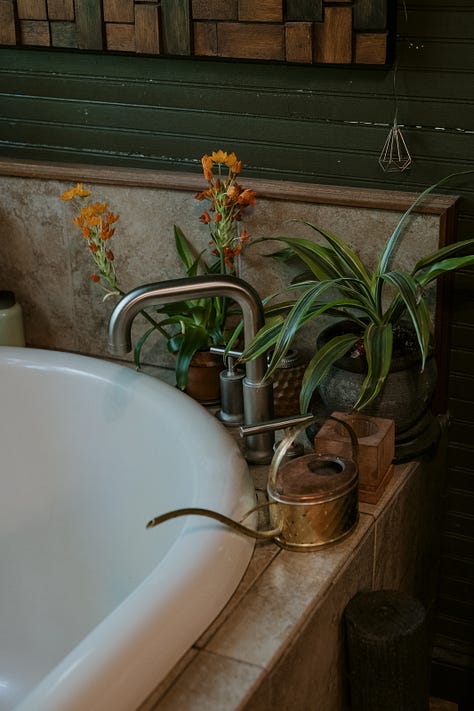






I loved that you had repeating patterns and themes throughout every space in your home (like the celestial themes or mixed artwork. Can you tell us more about those?
The gist of that is touched on above, but we should probably note the influence of “systems theory” and postmodern philosophies such as poststructuralism as well, which couch the world around us and in us in terms of relationships rather than isolated objects.
A century ago, John Dewey, the philosopher, educator, and library scientist, observed how the Western parsing of aesthetic objects, exemplified by museums, where everything is put on a pedestal under glass or on a blank white wall, robbed the aesthetic objects of their spiritual and culture gestalt, which in traditional/tribal cultures was found in their complex relationships from utility, to artistic, to familial bonding. He talked about how those aesthetic objects lost their real meaning when divorced from those relationships.
For our living environment, inside and out, we are constantly thinking about the complex web of relationships that creates the gestalt of place that we abstractly but meaningfully see as “home.”






How does your home facilitate the life you want to live with your family?
We hope for it to be a place of both comfort and inspiration. In ecological studies, diversity is seen as the cornerstone undergirding all healthy ecosystems. We see this as both a metaphorical and literal foundation for the design approach to our living space. To embrace nature is to embrace the complexity and abundance of diversity that fosters harmony, so rather than trying to erase and control the vibrant patina of our living environment, we do our best to dance and sing along.
How does sustainability & mindfulness play into your home decor?
That’s challenging to fit into a quick summation. We both have training in environmentalism, and it informs and undergirds everything we do, but in ways that are broader, deeper, and more inclusive than the soundbite binary reductionism that often informs environmental discourse. For us, it is more about our relationship with this world, and the recognition that nothing exists outside of nature, than it is about greenwashing, virtue-signaling, or simplistic solutions.






You have so much beautiful artwork and natural pieces (like the ephemeral boards, hanging rock vases, and more) throughout your home. Can you tell us a bit about where you shop and/or source your decor items?
Books don’t pay a whole lot, so we’re often rather limited financially when it comes to home decor. But that’s not a bad thing, necessarily, as it compels us to find creative solutions to decorating on the cheap. That often leads to discoveries that likely never would have been found if we had more money to rely on, and we’re thankful for that.
We make a lot of things by hand, employ found objects from the woods and garden, and get a lot of stuff secondhand from thrift stores, which we rework and recombine in novel ways to create playfully new and interesting contexts. Everything we do is deeply rooted in our appreciation of wonder.



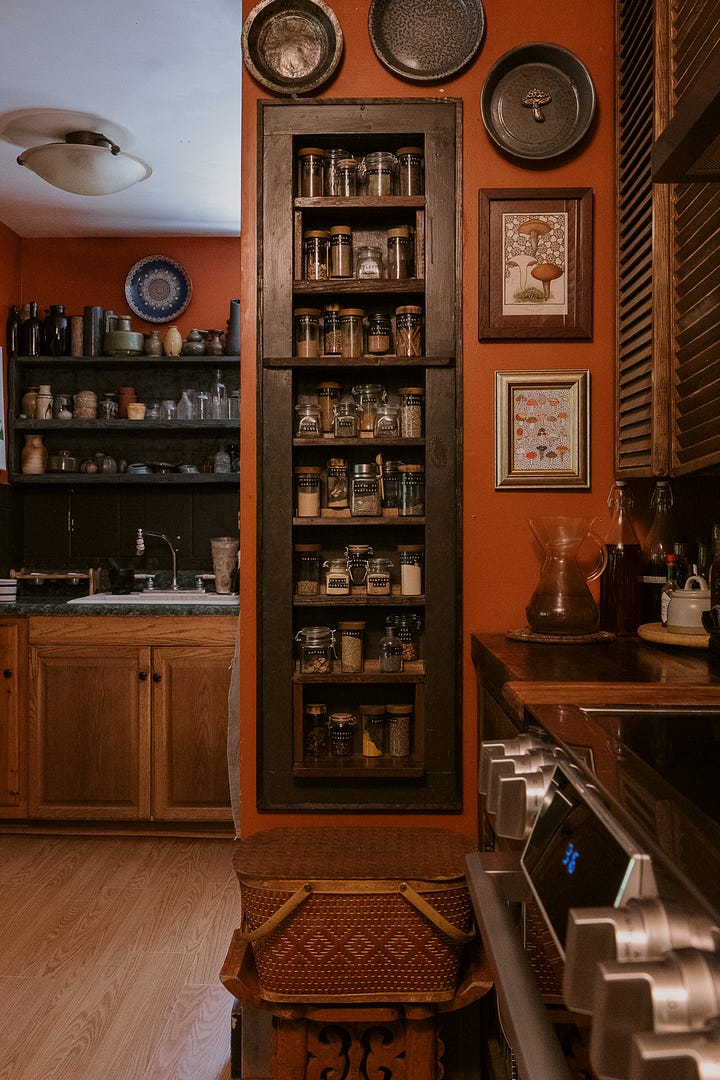

Your home is a darker space than most. Can you share a bit more about why that is and how you’ve embraced that in your design choices?
The house was built before air-conditioning, so it was purposely oriented to limit the bright light coming in. There are times when it is challenging, but in many ways we appreciate the cozy environment.
It’s all relative, I suppose. We’re outside a lot. A whole lot, because we’re in a clearing surrounded by forest in every direction. Because of that, yearning for bright views of wide open spaces while indoors isn’t really a thing for us. Someone once compared our home to a warm hug, and that quiet comfort is exactly what we’re going for.









I love how unique and fun your boys’ rooms are! How do you incorporate who they are into their room designs? Do they make some or all of the choices about how their spaces are decorated?
It’s a combination. At this point, our oldest son, Huxley, makes virtually all of the decorative choices for his room, though we do make suggestions based on what he likes, and we help him track down, frame, and hang up the art he chooses.
Our youngest son Alistair’s room was designed based on talking to him about what he likes and doesn’t like. He was very involved in coming up with the theme (land and sky meets Victorian explorer/naturalist’s curiosity cabinets), and he often helps pick out pictures and figurines from thrift stores. When we find something we think he’ll like, we always run it by him before putting it up.
The tiny room that we call the “Alice In Wonderland cave” was there before Alistair moved into that room (which used to be his older brother’s), but we added some personal touches there, as well. It has lots of plushies and pillows, a mini door meant to mimic the bedroom door, and spy holes in the backs of the cabinets so he can look out to his room.
How does your home make you feel? What aspects bring you rest, peace, wellness?
Our home feels like a friend. We anthropomorphize it, and that’s fine with us. Like a close friend or family member, there are days when its quirks can be a challenge, but it’s hard to imagine life without it. It’s immeasurably comforting and inspiring, and we’re always appreciative of that.





What is one difficulty you faced in decorating your home?
There are several, but they all have their pros and cons. The original bead board walls have lots of character, but they can be a challenge to paint and maintain. I found that distressing them takes some work, but the texture is wonderful and worth it.
The small size presents storage challenges and there isn’t a lot of space for large artworks, but that can also be a blessing. The lack of bright light that makes it feel so cozy can also sometimes be a challenge, but we’ve come to embrace it. As a professional color consultant, Glenn was surprised that it was as much of a challenge as it was. Originally, he kept trying to brighten up the palette to counter the darkness, but that wasn’t working, and he kept having to repaint. Eventually, he discovered that going with it, embracing the coziness rather than fighting it, was the best solution.





What’s one piece of advice you’d give to someone decorating their space?
Don’t be afraid of experimenting, and take the time to figure out what it is that truly resonates with you, instead of just reflecting the trend du jour. Learn to love and embrace your quirky peculiarities. Be playful with your living environment, because most of the best aesthetic discoveries are born out of play. Lastly, be less concerned with having people be impressed by your home as they are with feeling welcomed and comfortable while in it. Home truly is where the heart is.



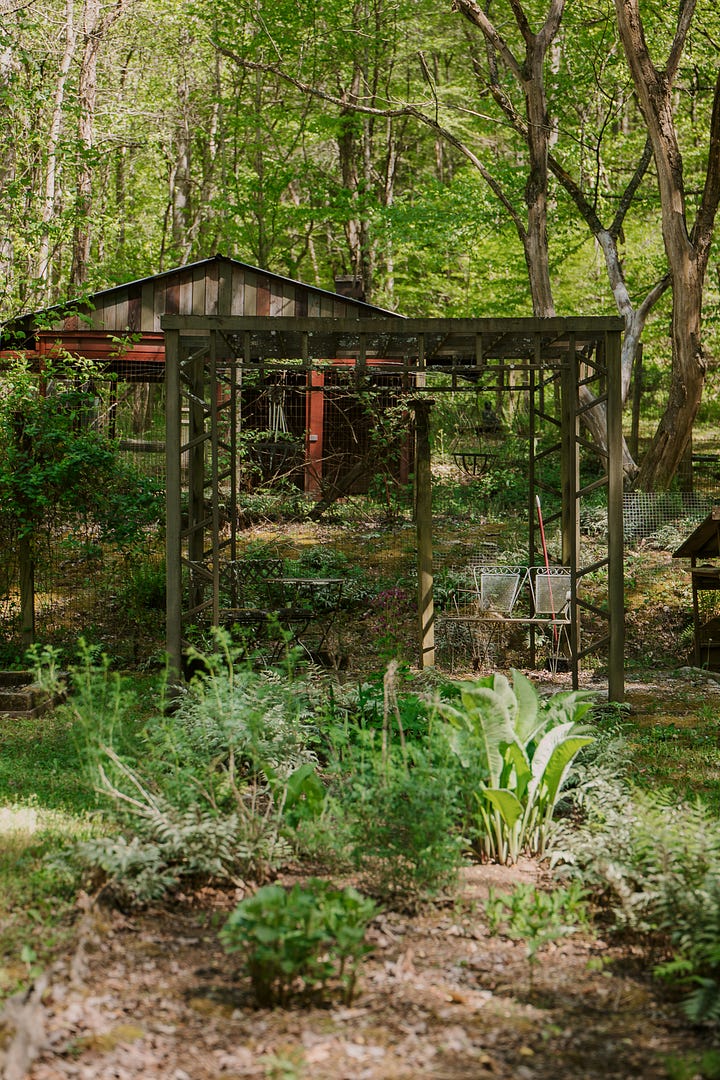
What do you love/appreciate about living in Appalachia?
So, so many things. We love the long autumns and springs, and the mild winters and summers. The fall leaves are amazing, and every year people come from all over the world to appreciate them, but the springs are not to be overlooked either. We know of no other place that is as festooned with flowers as WNC throughout the spring.
We love the rain, the fog, and the clouds. The Cherokee called this “the land of sky” not for the panoramic vistas of the sky, since the mountains are usually in the way, but for how the clouds nestle right into the mountains, so we walk among them.
We love the biodiversity! Research found that this area has the most biodiversity in Northern America because of the rain, the varying elevations, and being at the crux between northern and southern growing zones.
The people really are wonderful. They are remarkably kind, and unlike many parts of the US, most everybody is happy to talk to everyone else in the checkout line or wherever else. Asheville has unparalleled progressivism for a city in the Southeast, and for a city its size, the art, music, and culinary offerings are astounding.
To follow along with Ashley & Glenn and their inspiring work, you can follow them on Instagram, take a class they are teaching, or purchase any of their many books via their website.
Thank you so much Ashley & Glenn, for sharing your story and your home with us!
If you are local to the Asheville, NC & surrounding area and would like to be featured in Abodes of Appalachia, email me at kathryn@evergreeneradesign.com.
Missed the Last Episode?
Check it out here:
Abodes of Appalachia: Featuring Amelia Caristo
Hi friends! Welcome to 'Abodes of Appalachia,' a captivating series that delves into the heart and homes of the people who live amongst the rolling hills of the Blue Ridge Mountains. In this unique exploration, we celebrate the soulful essence of the Appalachian Region through the lens of interior design and the stories that dwell within these walls.




